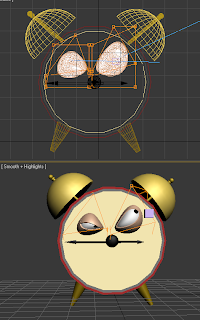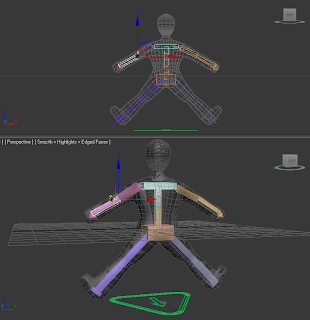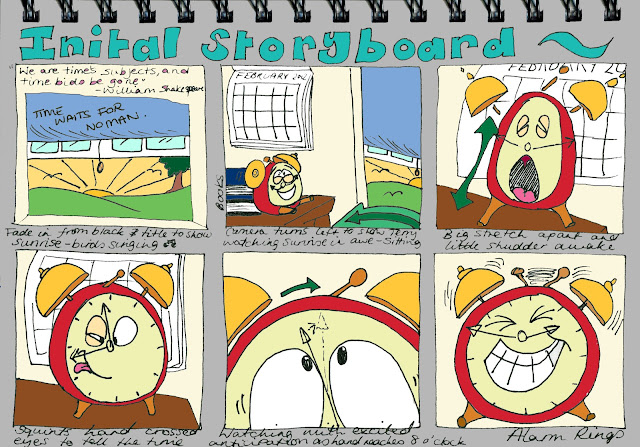During tutorial 2 we did a task that involved creating a persona for a generic character to make him more unique and to give him characteristics that make him more of a character with a back story. On the left you can see the character and the features I gave to him to make him more believable and lifelike.
As the tutorial above had shown, I needed to create a persona for my chosen character. To start with I decided on what my character would actually be.
I asked a couple of friends and family to ask their relatives between the ages of 7 and 11 who their favourite villains were and also what they dislike most. Many of the responses I got were the characters that I had already researched. The most interesting answers I received were to the "What do you dislike most?" question. To this question, the responses varied including school, getting up for school, bedtime, peas and spiders. I particularly identified with 'getting up for school' because my personal villain is my alarm clock and getting up for work! I then decided that as most of my sketches and research thus far had led me down the rather stereotypical route of how villainy has been portrayed, I thought that I would avoid this by making my character not look particularly menacing on face value but rather have an evil streak. Taking how the Beano's depicted villainous behaviour using the facial features of the character, I thought I could still create a 'villain' but avoid the trappings of his or her appearance being too obvious.
A favourite character of mine of all time has to be Pixar's Luxo Lamp, becoming integrated with the companies identity and the short animation of the big and small lamp of the same name.
I particularly like this character and animation because the character and expression of both lamps are so clear and yet the lamps do not even have faces. Using this idea I thought that I could perhaps create a villain from an everyday object, namely my alarm clock.

As you can see on the left, I started to brainstorm my alarm clock's persona and his characteristics.
On the right I started to generate an illustrative depiction of how my alarm clock might look. During my time spent sketching how my alarm clock might look I remembered Disney's Beauty and the Beast had a clock character called Cogsworth which I decided to research for inspiration.
Cogsworth

Researching Cogsworth online led me to some sketched expressions of Cogsworth. I sketched these out myself adding an alarm clock surround on a couple to see how a face would work within my idea. The original sketch image can be found at the link below.
I found I really liked the idea of using a face as the expression would be much clearer and presumably stronger for the young audience to pick up on.
Whilst primarily focusing on expression and visual research to do with Cogsworth (as I didn't want to be influenced too heavily on using similar aspects for my alarm clock fellow) I did stumble upon a biography of Cogsworth that I thought gave an accurate description of his persona.
I decided to use categories that had been used to describe Cogsworth and relate them to my own character.

Here is the character development that I came up with for my character, now christened 'Sir' Terry Timepiece. I decided he is not officially knighted, however he likes the title and thinks that it gives him status, which he is very preoccupied with as he feels that good timekeeping and punctuality are of the utmost importance.
For clarity I have re-typed 'Sir' Terry's final biography here;
Name: 'Sir' Terry Timepiece
Personality: Terry is pompous, self-important, has a superiority complex, rude, abrupt, annoying and suffers OCD regarding time keeping and punctuality
Appearance: Short in stature, slightly plump, unfit (winding gives him extra energy), he has a moustache (the hands of the clock face) large goggly eyes, two alarm bells on his head and two stumpy little legs
Goal: To make the world realise the importance of punctuality and get everyone up on time, more specifically his 'person' Timmy
Home: Timmy's bedside cabinet
Affiliations and Allies: Terry is a bit of a loner, no real friends to speak of although he has a soft spot for Timmy's wristwatch Tracy
Enemies: More modern timepieces such as digital alarm clocks, mobile phone alarm clocks and he hates cockerels
Likes: Terry loves to watch the sunrise, he enjoys waking people and takes pleasure from startling people. He likes traditional mechanics such as clockwork, cogs and gears. He collects stamps, enjoys playing with stray bits of blue tack with his little legs and he secretly likes the pat on the head he receives after waking someone up
Dislikes: Daylight saving time. He hates people who are early and despises people who are late. He also dislikes laziness
Powers/Abilities: Can ring his alarm bells at will, always has the correct time
Fate: Terry is replaced by a digital radio after smashing on the floor of Timmy's room
Quotes: Terry likes to quote Louis the XVIII of France "Punctuality is the politeness of kings" (this is another reason he likes to refer to himself as 'Sir' Timepiece)


































